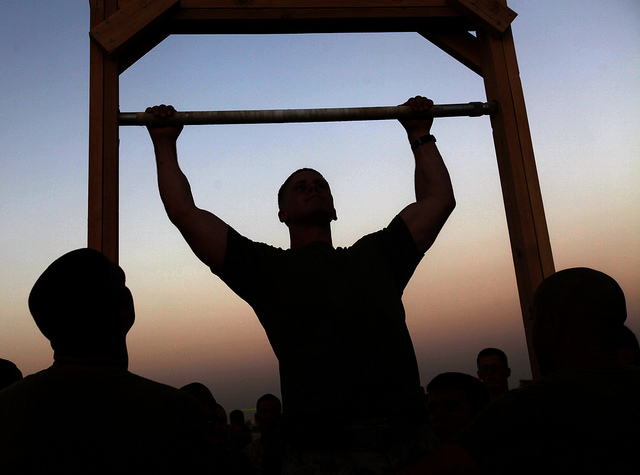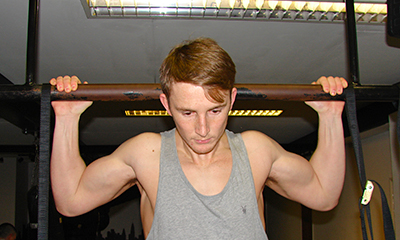For most people pull-up is a rather challenging exercise. We often hear that our clients’ long-term fitness goals include things like achieving 1, 10 or even 100 repetitions of pull-ups. For many the pinnacle of mastering this exercise is the ability to execute a perfect muscle-up – an extremely challenging exercise which is a mixture of a pull up and a straight-bar bodyweight dip. While there is nothing wrong with trying to achieve 100 consecutive reps of traditional pull-ups, at one point the value of every rep added starts to decrease.
 Our approach is to focus on variety instead of adding more and more reps of exactly the same exercise. Unfortunately most of the time when people think about pull-up training only two exercises come into their mind – regular (military/shoulder with) pull-ups and chin-ups (the same as a pull-up, only palms are facing towards your body). In this article will try to introduce you to the endless variations and progressions pull up training can offer.
Our approach is to focus on variety instead of adding more and more reps of exactly the same exercise. Unfortunately most of the time when people think about pull-up training only two exercises come into their mind – regular (military/shoulder with) pull-ups and chin-ups (the same as a pull-up, only palms are facing towards your body). In this article will try to introduce you to the endless variations and progressions pull up training can offer.
Each variation targets your muscles in a slightly different way, thus providing a well-rounded workout. Lets take running as an example. Very different skills are needed to compete in 100m sprints, mountain marathons and 100+ mile ultra-marathons. The ability to compete in all of these disciplines would make that person a very well rounded athlete. It’s the same with pull-ups. The more different variations you will do, the better you will be able to condition your upper back, shoulder and hand muscles.
We believe that for general fitness it’s better to be a generalist rather than a specialist in just couple movements. Before we get into the fun stuff, lets take a look at some basic principles and practices.
How to do Pull-ups safely?
Injury prevention should be your main focus when performing any kind of physical exercises. Here are some tips you should always remember when performing regular pull-ups and other closely related exercises.
1. Try to inhale on your way down and exhale on your way up. This isn’t a firm rule and you should adapt to the patterns that feel most natural to your body. The main thing is that you shouldn’t hold your breath for too long.
2. Keep your body straight and aligned. Engage your core muscles and focus on smooth movements. Rocking back and forth and other movements that help to generate momentum should be only used when performing more advanced pull-up variations like the kipping pull-ups.
3. Lower yourself until your arms are fully extended, but always keep your shoulders pulled into their sockets. Never relax them completely. When pulling yourself up try to go as high as you can. Forget about the “chin above the bar”. If you are a beginner and can just get your nose above the bar, then do it that way. If you are an expert and can touch the bar with your chest or upper abdomen, than that’s how high you should be going.
Basic Pull-up variations – wide grip, close grip, chin-ups and regular (military)
In this paragraph we will briefly look at the four most common pull up variations: close grip pull-ups, wide grip pull-ups, military pull-ups and chin-ups.
• Regular (military) Pull-ups
This is the most common pull-up variation. When performing this variation make sure that your palms are a bit wider than shoulder with apart and are facing away from your body. Pull yourself up in a slow and controlled manner while keeping your body as straight as possible. Don’t rock back and forth to generate momentum. At this point we want to build up your strengths. Later in more advanced variations we will start to introduce the ”kipping” motion.

• Chin-ups
The only major difference between a chin-up and a pull-up is that you palms will be facing you. The change in the palm position will change the movement patterns thus triggering different muscle groups. For majority of people chin-ups are a bit easier than regular pull-ups. It’s due to the fact that chin–ups put a lot of emphasis on biceps. This muscle seems to be more developed than upper back (which is mainly utilised in regular pull-ups).

• Close grip Pull-ups
Very similar to the regular (military) pull-up with the difference that your palms should be exactly shoulder with apart. Be careful! Don’t perform this variation if you have issues with your wrist joints.

• Wide grip Pull-ups
When performing wide grip pull-ups keep your body nice and tight and place your palms wider than shoulder with apart. There is no real way to tell how wide you should place them. We wouldn’t suggest going extremely wide because it might put too much pressure on your wrist joints. The only time you can go very wide is if you have access to a pull up bar with bent ends. If you feel any pain or discomfort in your joints, adjust your palm placement until you feel comfortable.
Pull-up exercise variations & tips for beginners
If you are a beginner many bodyweight exercises (including pull-ups and chin-ups) might feel very challenging to you. We understand that many people can’t do even a single repetition of a pull-up. Don’t worry, there are some tricks and techniques that will help you to gain the strength you need for achieving your first perfect repetition. Our five favorites are the following:
• Assisted pull-ups. For this exercise you will need another person to help you. Grab the bar and let the other person hold your hips or legs. When you pull yourself up he should use his arms to push you up as well. The assistant should push you just a little so that you have plenty of work to do yourself. If you prefer to work out alone you can buy elastic resistance bands. Just throw them over the bar and put your knee or foot in the loop. That will help you a bit.

• Body row. While not a pull-up is still helps to develop the muscles you will need for harder pull-up variations. For this exercise you can use either a low hanging bar or gymnastic rings (or TRX). Grab the bar and fully extend your arms. Make sure that your body is in a straight line and your abs are engaged. While maintaining a good posture, pull your chest towards the bar. Pause and return back to the starting position.

• Jumping pull-ups. For this exercise you will need a bar that you can easily reach while standing on the ground. In a pull-up exercise the hardest part is pulling yourself up. Letting yourself down is the easy part. Grab the bar with both hands. Use your legs to jump up so that your chin is above the bar. Don’t drop down. Use all the strength you have to make the downward motion as slow as possible. Repeat this exercise until you can no longer jump high enough or your back muscles can’t carry your weight anymore.
• Static holds. Find a low-hanging bar or use a chair to access a regular height pull-up bar. Grab it and make sure that your chin is above the bar. Lift your feed and hold this position (with the chin above the bar) for as long as you can. If you start losing strength, don’t just jump off – lower yourself in a controlled manner. Static holds are very effective for building strength for more demanding movements.
• Negative pull-ups. Find a low-hanging bar or use a chair to access a regular height pull-up bar. Grab the bar so that you find yourself in the upper position of a pull-up. Slowly lower yourself back down. This exercise is very similar to the jumping pull-up.
More advanced pull-up variations
• Behind the head pull-ups – try to touch the bar with the back of your neck.

• Supper narrow grip pull-ups – Place your palms together as close as you can.

• One hand assisted pull-ups – grab the bar with one hand. Place your other hand on the wrist of the first one for additional support. Helps to develop grip strength.

• Diagonal pull-ups – try to touch your right palm with your left shoulder and vice versa.

• Mixed grip pull-ups – perform a regular pull-up with one hand facing you and the other hand facing away.

• Clapping pull-ups – perform explosive pull-ups where at the upper part of the pull-up you release your hands and make a quick clap.

• Ladder hand walking

• Fingertip pull-ups – find a narrow edge which is wide enough for you to place just your fingertips. Helps to develop finger strength for sports like rock climbing, mountain biking and motocross.
• Around the world pull-ups – use a full range of circular motion (up, down and sideways) to perform this variation.
• Side to side pull-ups – pull yourself up and while maintaining the upper position shift your body from one side to the other.
• Towel pull-ups – throw two towels over a bar. Grab the ends of the towels and pull yourself up. Helps to develop grip strength.
The list could go on and on…
Photo credit: United States Marine Corps Official Page via photopin cc



 sending...
sending...